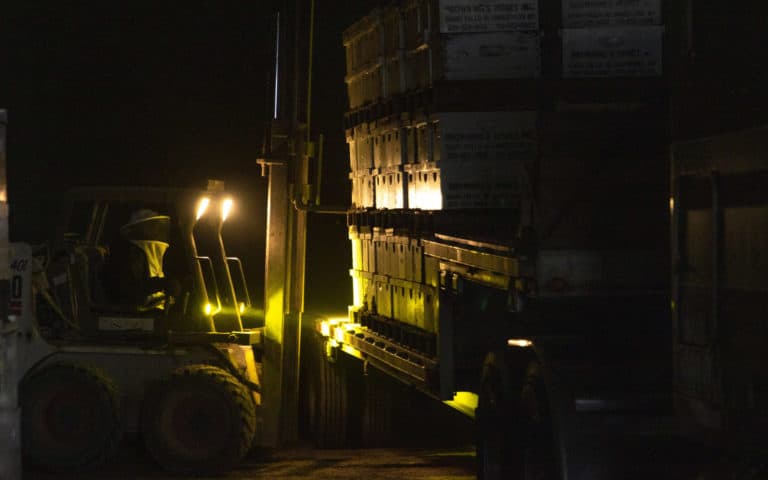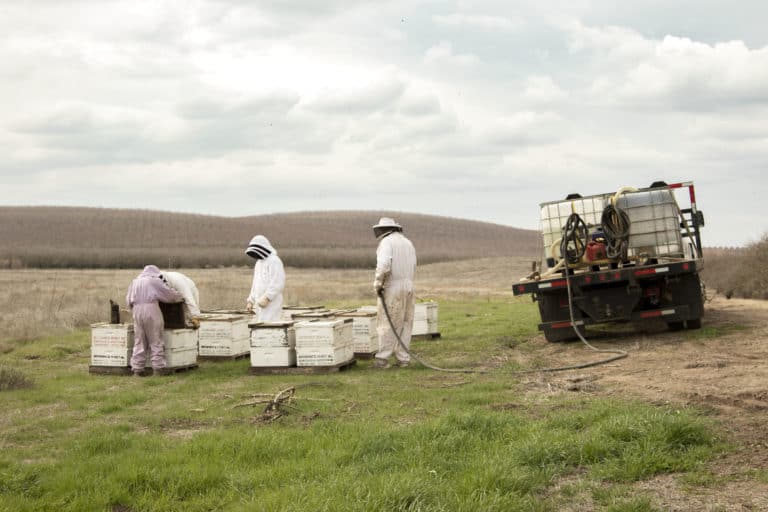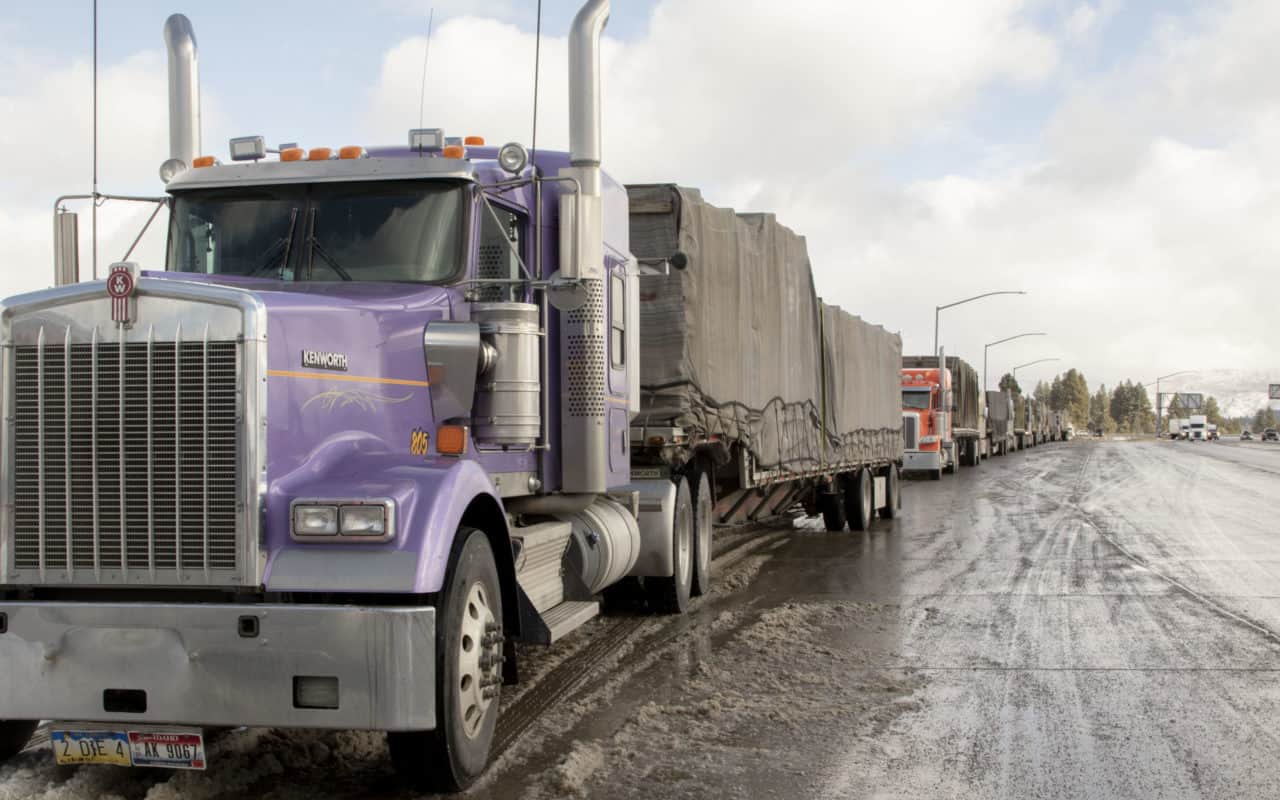Written by Grace Kunkel and Sharah Yaddaw, Project Apis m. team members
Taking honey bees out of indoor storage (or an over-wintering apiary) and transporting them to California in time for almond pollination is a massive, coordinated effort that commercial beekeepers undertake every year. It isn’t just the beekeepers that make it happen; experienced truck drivers, state inspectors staffing points of entry into California, and almond growers all coordinate for this event. Most importantly, mother nature determines the exact timing of the almond bloom and the driving conditions the truck drivers must navigate to get there.

Project Apis m.’s Director of Communications, Sharah Yaddaw, along with her partner Scott Hathaway got to be “bees on the wall” assembling a small, moving film-production to document the movement of colonies. Their film created a rare view into the largest commercial beekeeping event of the year. The video is available for anyone to watch, here.
Sharah answered a few questions about the making of the documentary below:
Q: What made you want to document this trip?
Moving bees across the country on trucks is something that has to happen in order for pollination of many commercial crops and to maintain our food supply. It’s a big undertaking. I knew the theory behind it and had heard stories and seen research about queen losses, temperature control, and drivers not being able to stop during daytime hours, but I wanted to experience this mysterious migration for myself and be able to share a look into it with the wider world in a fun and approachable way.
Beekeepers provide an essential service, but their day to day lives, and the effort it takes to pollinate, is not something that is widely considered. It’s fascinating and important.
Indoor storage is another interesting factor in this story – as more beekeepers look to indoor storage as a solution for overwintering bees that are destined for almond pollination, PAm and Washington State University are working on research and resources that support the practice. The bees we followed to almonds were coming out of indoor storage facilities that have been operating successfully since the 1990s, and I wanted to learn more about that process and capture some photos for the website resource we are building.
Q: What surprised you the most?
The speed at which the team of beekeepers was able to sort colonies coming out of cold storage for 70+ days, grade them, and load them on trucks so that when they arrived in the orchard every pallet would have a minimum 8-frame average of healthy bees.
The team used infrared sensors to do a preliminary check on the colonies and they also check the weights and open any hives that warrant a closer inspection. Colonies that don’t make the grade are separated out and sometimes combined and brought to California to build up, but these colonies won’t be rented for pollination.
It only took them about 20 minutes, once the pallets were ready, to load and secure over 400 colonies on a truck.

Q: What was the tenor/pace of the work taking place?
Efficient, fun and fast paced! These beekeepers had to work like a well-oiled machine to load and ship about 30,000 colonies in just a few short weeks. There was joking around and good nature, but everyone was taking the task seriously and working hard.
Q: How does the weather impact the bees on the road/how do the drivers handle that?
Weather is a huge factor when it comes to trucking bees. We encountered snow, sleet, and had to manage road closures as well. There are only a few roads in to California over the mountains, and choosing the right route relies on technology along with experience. Cold weather is actually ideal for transporting bees because overheating and flying are the main concerns. Merle and Earl, the truck drivers we travelled with, told us many stories of warm weather transport woes, from breaking down in the middle of North Dakota with a full load to driving alongside flying bees that are caught in the draft of the truck when it’s hot outside. If they have to stop in warmer weather, they pull away from the stop very slowly which helps draw any bees that have escaped the nets away from any unsuspecting public. There is truly an art to it.
Q: What did you think of the drive?
I totally felt like I was a long-haul trucker, haha! I’ve driven most of those roads before and the main difference was that it was really slow compared to driving it in a small car. We were also making a lot of “film” decisions like going ahead to set up a camera and capture shots or shooting out of the window of our van. We got to see Merle and Earl’s favorite overnight stop along the road and really felt like a part of the crew. They were very nice to let us put cameras in their trucks and ask them a million questions, and we were grateful to be teamed up with them.
Q: From starting to pull colonies out of the shed to arriving at the almond orchard, how many miles were traveled and how much time had elapsed?
We arrived at Browning’s Honey in Blackfoot Idaho at 8am Thursday morning and watched the process for the day taking photos and conducting some interviews. On Friday morning, we watched them load the trucks we would follow and rolled out about 11:30. By 5:45 Saturday night we were in the Central Valley and the bees were unloaded that day. The drive is between 800-900 miles.
Timing of arrival is actually really important, and we arrived in the orchard at dusk. This prevents losing bees to flying, gives them a chance to orient themselves. In just a couple of hours upon our arrival, all 800 plus colonies we traveled with were placed in orchards ready for pollination, and double checked for health and 8-frame averages. Beekeepers usually don’t bother them for a couple of days and then will have crews feed them to get them building up before the bloom.

Q: Is there anything else you want people to know about the making of the video?
It was really amazing to see how many factors must be considered, and how much careful management goes into making sure that healthy bees come out of storage after making honey all summer and get safely to California in the middle of the winter. You can really see the “Four Ps” come into play here. Bees must be in good shape before they are put into storage, which means reduced health from “Poor Nutrition, Parasites, Pathogens, or Pesticides” has a direct impact on the ability to show up for pollination with bees that will get the job done well. Almond pollination is a big part of beekeeping and happens quickly over just a few weeks, but beekeepers must prepare for it all year through good management practices.
On our drive back to Salt Lake City we counted at least 25 truckloads of bees on I-80 between the California Border and Utah. We accompanied 2 truckloads and that seemed like a lot of bees, but the reality is that over 4,000 loads are transported from as far away as the East Coast to pollinate almonds. It is an incredible feat!
Making this video was possible with generous cooperation and access provided by Browning’s Honey, and all of the hard work and skill of the employees.
